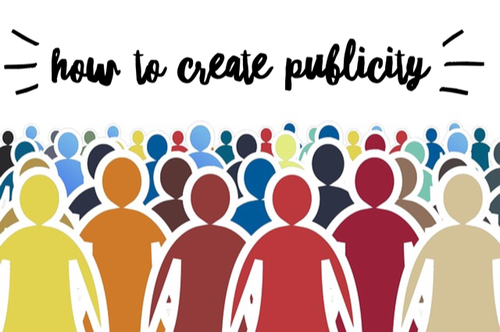by guest blogger Todd Scalise
Publicity is an area of business that most artists do not take advantage of, for some good reasons. With more and more media in our lives, it can be difficult to know where to start.

Moreover, making art is sensitive business, so it can be difficult for creative professionals to communicate directly to their audience without appearing like they are just talking about themselves. Despite these hurdles, I have come to realize that gaining publicity is a creative exercise which involves something that artists are typically very good at: problem solving.
We see the first signs of artists with a knack for publicity in the mid-1400’s directly after the advent of the printing press. Albrecht Dürer (1471-1528) established his reputation as a major player of the German Renaissance in his early twenties with the creation of easily reproducible and affordable woodblock prints.
Collectors buzzed about these prints as an inexpensive alternative to his painted masterworks which only numbered in the dozens. What these prints did for Dürer is the same as what modern publicity does for artists today: promote and stimulate interest to an audience through the repetition of a message. Once the word was out, his private commissions soared, establishing him as one of the most sought after artists in Northern Europe during his lifetime.
A generation later, Pope Julius II commissioned Michelangelo (1475-1564) to paint the Sistine Chapel ceiling. It may not be totally apparent to us today, but the primary reason why the Sistine Chapel Ceiling was painted was for publicity.
Pope Julius II wanted to project an image of Christian Rome that rivaled the glory of Ancient Rome. The Sistine Chapel ceiling has dramatically increased the awareness of the Vatican’s position around the world. To this day, the Vatican is still capitalizing on the return on investment (ROI) of Michelangelo’s unbelievable talent.
In the late Twentieth Century, long after the advent of mass media, we see the use of publicity forming the careers of many artists. Jackson Pollock hired public relations agent Eleanor Lambert, who specialized in promoting artist’s careers. Andy Warhol capitalized his creative enterprise through publicity in his magazine, Interview. And then there’s Jeff Koons, who in his attempt to rise to the top of the art world, used billboards to publicize his work all around Manhattan.
So why don’t we commonly hear about these examples of artist publicity? It may be because the art world would rather have you believe that all creatives rise to the top based on merit alone. This is simply not true. Other creative professionals, such as those in the film industry, rely heavily on publicity because it has a direct correlation to ticket sales. Henceforth, if you are in business as an artist, publicity can help you connect with collectors or clients of your artwork.
Focus on your audience, not yourself
The first step in gaining publicity for your artwork starts by formulating a compelling press release. Yet, most artists communicate through an artist statement.
There is a fundamental difference between the structure of an artist statement and that of a press release. The artist statement functions well for a museum or gallery discussion, but the format can be problematic when it comes to attracting public attention. This is because most traditional artist statements either focus on the artist (the proverbial “I”) or the artwork. Rarely do they focus on the “audience” for the artwork. This is where your press release begins.
An artist press release should begin by talking about the community or audience for which the artwork was created. A description about the artwork with the “why” and “how” it was created comes next. Finally, you can put information about yourself as an artist. By acknowledging the audience first, this format prevents artists from appearing self-centered. This methodical way of communicating also helps place the community at the center of your creative enterprise. Once your press release is well formulated, you can begin to tailor your message to a variety of different audiences.
Publicity is free
The best part about publicity is that you don’t pay for it; you earn it. Earned media (or free media) refers to publicity gained through promotional efforts other than advertising, as opposed to paid media, which refers to publicity gained through advertising.
When media outlets contact you because you sent them a really interesting press release, they should be doing so because you are doing something noteworthy that their audience would like to know more about. This means that you don’t need to buy advertisements in order to gain exposure which commonly comes in the form of a review, article, tv or radio spot.
However, since media outlets rely on some form of advertising to generate profit, be prepared for a follow-up sales call. I suggest keeping your options open with this one simple sentence: “I would entertain becoming an advertiser only after your audience becomes more aware of my artwork.” Once you have established an audience, a paid advertisement may make sense. Either way, if the outlet is reputable, they will be excited to talk about your artwork regardless.
Systematize success
Great publicity is built from one opportunity to another. In other words, publicity is not a one-time affair. Rather, it is a system of events gradually building upon one another with lasting audience attention to the most important artwork out there: yours.
If only one outlet is talking about your artwork then maybe it is time to reevaluate the way you are talking to your audiences. The goal is to create two or three simultaneous campaigns with various media outlets. Then you have a winning formula for creating awareness that’s always free.
Let’s start creating publicity
As I said before, artists make for good problem solvers, but planning and strategizing is another story. Remember, it’s incredibly difficult to move ahead without a compelling press release, so work on that first. I use a copywriter to proof most of my writing because I drew during English class. When I begin to push out my press release to various media outlets, I track that activity in a spreadsheet by recording several details:
- the date & time
- name of contact
- media outlet
- current campaign
This makes for great, user-friendly, at-a-glance record keeping. This information will help you repeat successful campaigns and minimize the time spent on contacts who do not seem to have the same level of interest about your artwork as you do. Over time, discipline becomes habit. Ultimately, when your publicity is working well, you will always have an audience to talk to.
 Todd Scalise is the CEO and Founder of Higherglyphics LLC ,a visual public relations firm that creates art in public places. They combine community art with turnkey project management, expert installation and merchandising to establish recognition for the communities they serve.
Todd Scalise is the CEO and Founder of Higherglyphics LLC ,a visual public relations firm that creates art in public places. They combine community art with turnkey project management, expert installation and merchandising to establish recognition for the communities they serve.



What a great article. Thank you Todd, very helpful.